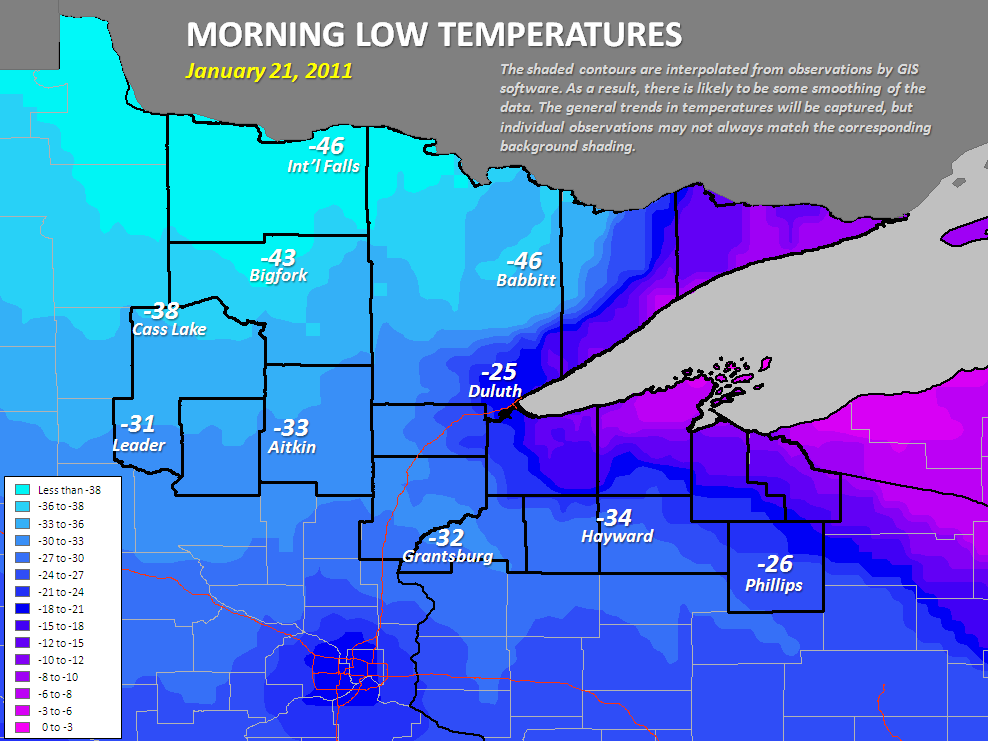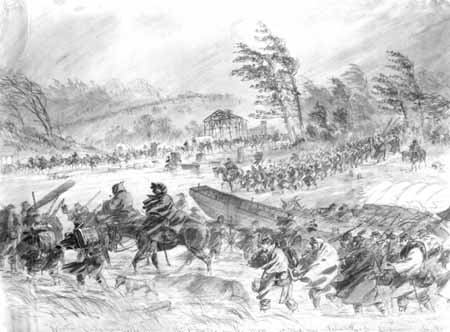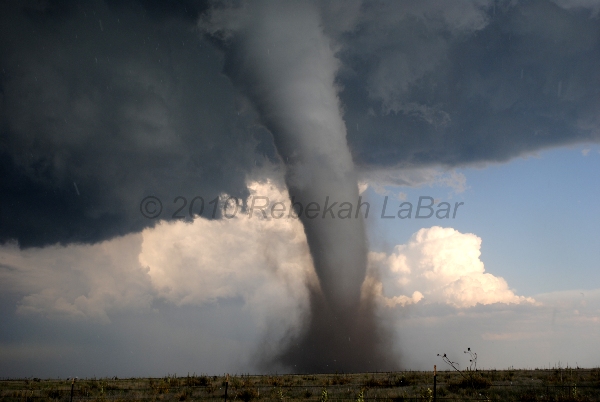01.24.11
Posted in Weather Education at 8:00 am by Rebekah
The seven elements of weather (temperature, pressure, wind, moisture, clouds, precipitation, and visibility) can all be boiled down to temperature, pressure, and moisture. A couple of weeks ago we looked at temperature, last week we looked at pressure, and next week we will look at moisture. Today we’re going to take a brief look at wind, which is related to pressure.
————————————————–
Wind
Wind is the motion of air, caused by a difference in pressure.

As I’ve said before, the earth and the atmosphere is always trying to balance out any inequalities. Note the figure above. The column of air on the left has more molecules (thus has a higher pressure) than the column on the right. Some of these molecules will “want” to move over to the right, to balance out the two columns.
This illustrates a key principle of the atmosphere: wind blows from high to low pressure. Furthermore, the stronger the pressure gradient (i.e., the greater the pressure difference), the stronger the wind (e.g., think of the low pressure inside of and strong pressure gradients in hurricanes).
————————————————–
Come back next Monday as we talk about moisture, the next element of weather.
Permalink
01.23.11
Posted in Weather News at 8:00 am by Rebekah

Percent of normal precipitation for the U.S. in December 2010. Source: Climate Prediction Center.
While the western U.S. may be flooding, the south central and southeastern U.S. has been dry. Here’s a link to a NOAA report from Thursday about the drought conditions in the southern U.S., including images of the latest drought monitor and drought outlook.
Lubbock, in western Texas, currently has a streak of 71 days (today will be day 72) of no measurable precipitation. This streak is now 7th on the list of longest dry spells. The record for most consecutive days with no measurable precipitation was set in the winter of 2005/2006 (anyone remember the fires?), at 98 days.
Here’s a link to the top 36 dry periods at Lubbock, from the Lubbock National Weather Service office. Keep checking it out from time to time, as the models are showing that this current dry streak could certainly give 2005/2006 a run for its money!
Permalink
01.22.11
Posted in Weather News, Winter Weather at 8:00 am by Rebekah
National Weather Service offices in the Dakotas and Minnesota decided to start using a new type of warning this week, called an “extreme cold warning“.
An extreme cold warning will be issued when the air temperature is forecast to drop to 40 below zero and lower, with little or calm wind (previously only a wind chill warning could be issued for such cold temperatures, but this is meant to be more for when there is not much wind).
Thursday night, the NWS in Duluth had the chance to issue their first extreme cold warning, and it certainly verified; International Falls recorded a low of 46 below, tied for their 5th lowest temperature on record.

See more info about the cold on the NWS Duluth page here. See also the NWS link to more info on the experimental extreme cold warning.
Permalink
01.21.11
Posted in Uncategorized at 8:00 am by Rebekah
The Mud March was the ill-fated attempt by Union Army Major General Ambrose Burnside to defeat Confederate General Robert E. Lee in the Civil War near the Rappahannock River south of Fredericksburg, Virginia.

The Mud March. From “Washington Weather“
Background
In December 1862, Burnside led a frontal attack on Lee’s army near Fredericksburg. The Confederate Army of Northern Virginia soundly beat the Union Army of the Potomac, however, and the Battle of Fredericksburg came to be known as one of the most one-sided battles of the Civil War.
The Plan
In January 1863, Burnside, desperate to restore his reputation and the morale of his army, planned another surprise attack on Lee’s army just south of Fredericksburg. His army would cross the Rappahannock River to flank the Confederates, while the Union cavalry would cross the river 20 miles to the north and then come in from the rear.
President Abraham Lincoln found out about the plan and believed it was too risky, but Burnside only changed the point of his river crossing, by moving further upstream.
The Mud March
On January 20, 1863, the anticipated day of attack, a strong extratropical cyclone began to move up the East Coast. The nor’easter brought heavy rainfall to the coast and snowfall further inland. The rain continued for two days (Washington, DC reported 3.2 inches of rain), saturating the ground and turning the dirt roads into thick mud. Gale-force winds also blew and temperatures near Fredericksburg were in the upper 30s.
Burnside tried to keep going, but after the troops struggled to move in knee-deep mud, the wagons got buried up to their wheel hubs, the artillery got stuck, and teams of horses and mules became exhausted and died, he finally listened to the complaints of his army and decided to head back to camp. Reportedly, a team of a dozen horses and 150 men could not pull even one cannon out of the mud. Eventually, after placing logs on the mud, the army was able to make it out of the mess and get back to camp. The soldiers derisively called the trek the “Mud March”.
After Effects
On January 26, President Lincoln replaced Burnside with Major General Joseph Hooker. The Mud March was the last attempted major winter offensive during the Civil War.
Side note: Burnside had at the time what was considered rather unusual facial hair. The strips of hair down the sides of his face came to be called “burnsides“, and later what today we call sideburns.
——————–
Sources: Washington Weather and Wikipedia
Permalink
01.20.11
Posted in Weather Education, Weather Myths at 8:00 am by Rebekah

Here are a few myths about tornadoes that you might have heard.
- Myth: “You should open windows to equalize air pressure.”
- Fact: Although tornadoes may have a low pressure center, houses are well-ventilated and pressure differences would be equalized well before explosive pressure drops came close enough to the house. Opening windows is a waste of time and may just bring more flying debris into your home.
- Myth: “You should always shelter from tornadoes in the southwest side of your house.”
- Fact: Tornadoes often come from the southwest, which is possibly related to how this old myth got started. Instead, you should hide in the center of your house, in a closet, underneath heavy furniture, or under a stairwell.
- Myth: “A highway overpass is a good tornado shelter.”
- Fact: Although a TV station video from Kansas in 1991 showed that people got apparent protection under an overpass, they were just providentially spared (not to mention the tornado did not come directly over them, as presumed). An overpass actually creates a wind tunnel effect, such that the winds under the overpass can actually be even stronger than the winds in the tornado. You would also be directly exposed to flying debris. People have been killed hiding under overpasses (most notably on May 3, 1999 in Oklahoma City). Instead, if you are in a car and a tornado is nearby, you should drive away, if possible, or take shelter in any nearby buildings (staying inside a stationary car is not a good idea).
- Myth: “My town is protected from tornadoes by a river, hill, valley, Indian burial ground, etc.”
- Fact: The idea that your town is protected is a combination of perhaps wishful thinking, a short memory, and the rarity of tornadoes. Tornadoes don’t care about surface features, though, they are more driven by what’s going on aloft. When I moved to Norman, I heard that there was a “bubble” or “dome” that seemed to keep tornadoes in Oklahoma City but not Norman. Norman had been struck by tornadoes in the 70s and 80s, but not for a while. Well, the so-called “bubble” was popped recently, as east Norman was hit by a tornado in June 2009 and again by an EF4 tornado in May 2010.
Permalink
« Previous Page — « Previous entries « Previous Page · Next Page » Next entries » — Next Page »




